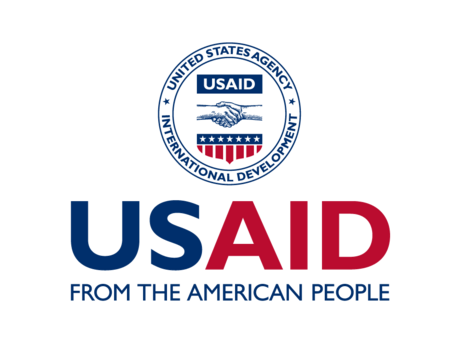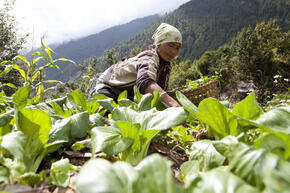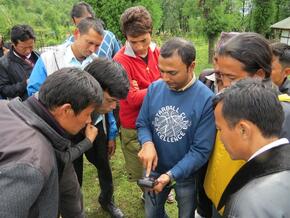Through this project, we seek to improve management of Asia’s high mountain landscape and address environmental issues in a comprehensive way that benefits both communities and ecosystems. This is the first time this has been attempted in a coordinated fashion across a vast swath of the snow leopard’s range, rather than just in isolated localities.
Snow Leopard Conservation
From snow leopard research to organizing regional conferences for their protection, WWF sees the species as a symbol of our conservation efforts in Asia’s high mountains. On the ground, we’re empowering local communities to monitor and survey snow leopards and perform anti-poaching initiatives. Project partners—including WWF, the Snow Leopard Trust, and snow leopard range-nation governments convene workshops to promote conservation of snow leopard habitat within the broader context of climate change and sustainable natural resource management.
Listen to the America Adapts podcast on the subject of snow leopard conservation.
Climate Adaptation
WWF is assessing climate vulnerability across the high mountain landscapes of Asia and identifying opportunities to increase the resiliency of mountain ecosystems. Through site-specific interventions, we promote climate-smart actions that integrate sustainable development, water security, and snow leopard conservation. Activities emphasize building capacity of local governments, increasing public understanding, and providing incentives for climate change adaptation work.
Water Security
Increasing the resiliency of these Asia’s high mountain ecosystems will help safeguard the headwaters of rivers upon which millions of people depend. Protecting freshwater resources, adapting practices to reduce human impacts, and embracing better water management at the local, national and regional levels will all prove crucial to securing water in the region. Activities range from local interventions—such as conducting springshed restorations, building water storage ponds, embracing water-efficient irrigation, and incentivizing communities to keep freshwater resources clean—to capacity building for government workers.
Food Security
Unreliable water availability and weather patterns are already changing the viability of traditional high mountain agricultural activities. WWF is assessing the impact for climate change on food security, helping local communities understand the issues, and training farmers and herders to embrace more sustainable and alternative practices. Activities range form addressing how food is grown (e.g. encouraging greenhouse gardening, bee-keeping and planting different crops or varietals) as well as how livestock is maintained (e.g. adopting sustainable pasture management practices and growing fodder crops on marginal or degraded lands). Such activities not only increase food security, but they also protect grassland ecosystems.
Sustainable Livelihoods
Climate change is severely impacting livelihoods in Asia’s high mountains and threatens communities with deep cultural ties to landscape. WWF aims to help diversify rural livelihoods and empower sustainable development that benefits both people and nature. These activities have significant benefits for women, as they are empowered to generate income through production of handicrafts, community-based ecotourism, marketing of yak and horse milk, poultry raising and egg production, and sewing, among other activities.
Education, Awareness and Engagement
WWF strives to raise awareness of the issues threatening Asia’s high mountain communities and encourage local participation in solutions. Activities include school programs, door-to-door education campaigning, creative events like snow leopard festivals, community-based bioidiversity monitioring and anti-poaching patrols,and integrating biodiversity conservation into livelihood activities.
Transnational Collaboration
WWF promotes transboundary cooperation on mountain conservation amongst snow leopard range countries. By increasing the availability of data, sharing lessons learned rangewide, and supporting climate-smart conservation activities, the project will strengthen existing linkages and form new channels for cooperation among existing regional conservation networks.













 Ryan Bartlett
Director, Climate Risk Management & Resilience
Ryan Bartlett
Director, Climate Risk Management & Resilience
 Shaun Martin
Vice President and Deputy, Climate Change
Shaun Martin
Vice President and Deputy, Climate Change